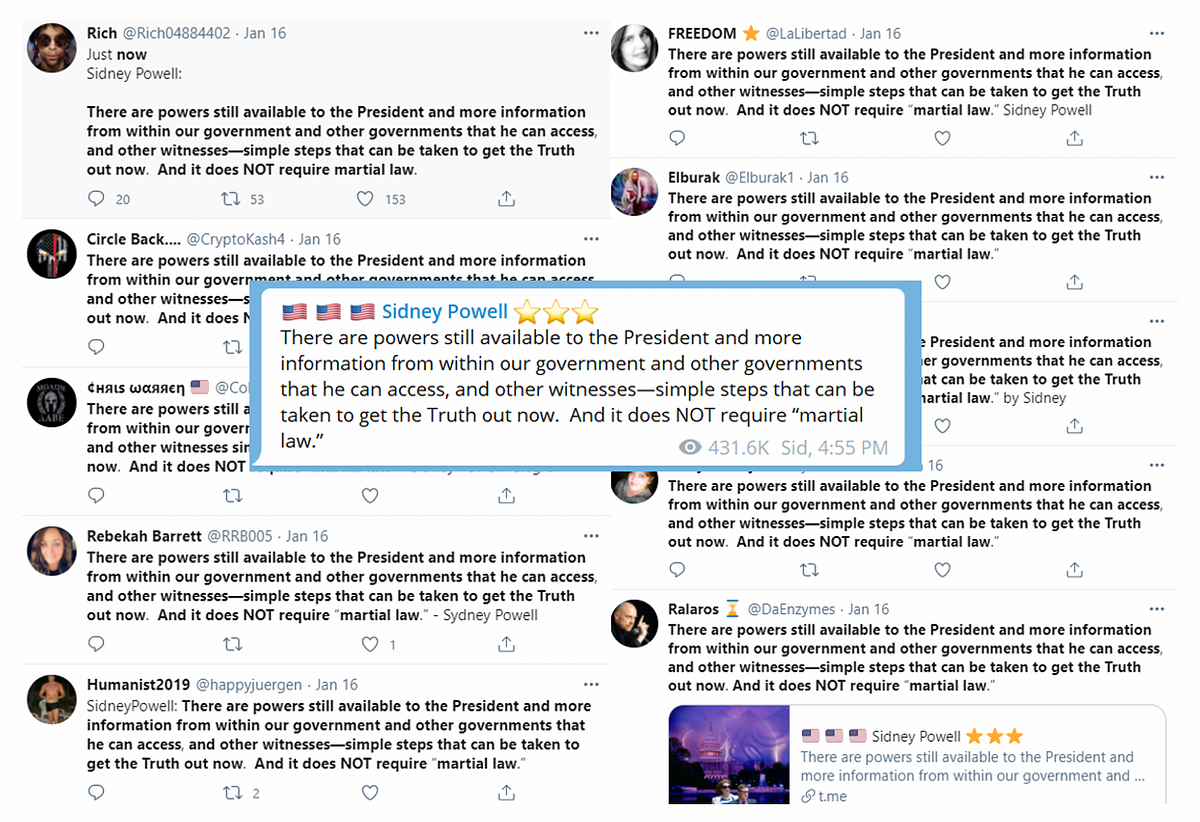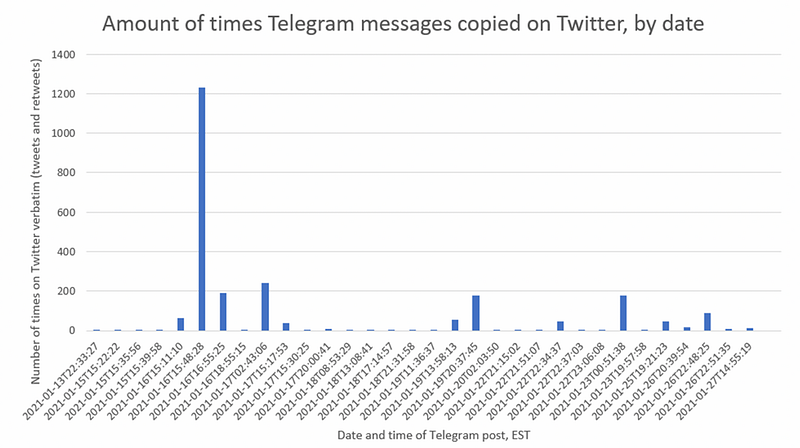A majority of Powell Telegram channel messages from January 2021 were also circulated on Twitter

Although pro-Trump attorney Sidney Powell was banned from Twitter after the violent insurrection at the U.S. Capitol, Twitter users are nonetheless circulating messages from a Sidney Powell Telegram channel, demonstrating that de-platforming an account does not necessarily eliminate its messages from the platform. A DFRLab review of 42 unique Telegram channel posts in January 2021 showed that 32 of them — or 76 percent — were also circulated on Twitter in at least 2,444 tweets or retweets.
Powell, a lawyer best known known for attempting to overturn the outcome of the 2020 U.S. presidential election, was banned from Twitter on January 8, 2021 for “Coordinated Harmful Activity,” as was former National Security Adviser Michael Flynn. Her Twitter ban came amid the de-platforming and migration of influential election deniers from mainstream social media platforms after January 6, including President Trump.
The context of the Telegram channel
The Sidney Powell Telegram channel, with over 360,000 subscribers, is the most popular Powell-related Telegram channel, and has been active since January 13, after being created November 30. According to the Telegram statistics tool telemetr.io, the channel has over 310,000 views per post, and has been growing in subscribers since its first post.
The channel frequently circulates conspiracies about the outcome of the U.S. election, foreign interference, and Dominion Voting, as well as frequently forwarding messages from pro-Trump fan channels and the channels of other prominent Trump crusaders, including fellow pro-Trump lawyer Lin Wood.
It purports to be the “official” channel of Powell, although this is unconfirmed. While some of the Telegram messages end with “-Sidney”, and one early post in the channel claimed, “All posts here will be made by me personally. Sidney,” there are two authors posting in the Telegram, one labeled “Sidney” and the other “S P”. Powell did not respond to DFRLab requests for verification. Even if the channel is not Powell herself, it is treated as such by both outside journalists and Powell’s own compatriots. For example, Lin Wood’s Telegram channel has forwarded Powell channel messages to his channel, while journalist Yashar Ali depicted the channel as hers on Twitter.
The Telegram-to-Twitter pipeline
A DFRLab analysis of the channel’s activity in January 2021 shows that the majority of unique Telegram posts were posted on Twitter verbatim by multiple users. Out of 42 unique messages on the channel in January, at least 32 of them — or 76 percent — were circulated on Twitter, in a total of 2,444 tweets or retweets. On average, a unique Telegram message from Powell was tweeted or retweeted 76 times. The tweets did not seem to garner much attention, however — the vast majority of tweets received zero likes, with an average of 0.60 likes per tweet and a median of zero. Many of the tweets specifically attributed the Telegram message to Powell, and some of them even linked the Telegram channel. The Telegram messages on Twitter were even translated into different languages to go alongside the English, including into French, Japanese, Chinese, and Hebrew.
The three Telegram messages that spread most on Twitter all occurred prior to the inauguration of President Biden, and concerned whether it was still possible for the election results to be overturned. On January 16, a Powell channel post asking for a miracle and prayers garnered at least 1,231 Twitter copies, and another message, stating “There are powers still available to the President” — implying that Trump could still do something ahead of inauguration — received at least 191 tweets or retweets.

The fourth most popular message, which was on January 19, talked about the dismissal of the Georgia lawsuit and claimed that Maricopa County, Arizona was going to audit ballots, stating “We have only begun to fight. We uncover more evidence of this criminal fraud by the day.” This message was amplified at least 177 times on Twitter.

After the inauguration, Powell’s Telegram posts continued to spread on Twitter. Some of the messages with many verbatim Twitter copies included an announcement of Powell’s new PAC, as well as a false allegation that Italy had interfered in the election.
Out of the 2,444 tweets and retweets, 94 percent were from unique users. Only a dozen accounts tweeted or retweeted Powell posts four or more times, and most of these accounts also tweeted in other languages, particularly Japanese. @lovepraywork100, the user who amplified the most Telegram messages — 11 — has since been suspended from Twitter.
On average, accounts only tweeted or retweeted a single Powell message, which is perhaps odd, considering that accounts interested in amplifying Powell Telegram messages to their followers would likely be interested in doing so more than a single time.
This Telegram-to-Twitter phenomenon shows that in certain instances, when users are forced from mainstream social media sites to alternative platforms, those mainstream sites still play a role in the dissemination of their messages. Despite being banned, Powell and the messages allegedly written by her have an indirect way of accessing Twitter — albeit without the amount of influence she previously had. This complicates the efficacy of de-platforming alone as a platform strategy against conspiratorial, extremist activity; solutions that seek to remove harmful content online must also consider how other users act as proxies to circumvent those solutions.
Alyssa Kann is a Research Assistant with the Digital Forensic Research Lab.
Follow along on Twitter for more in-depth analysis from our #DigitalSherlocks.

